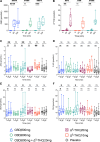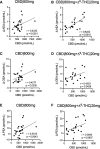Dose-dependent effects of oral cannabidiol and delta-9-tetrahydrocannabinol on serum anandamide and related N-acylethanolamines in healthy volunteers
- PMID: 39182921
- PMCID: PMC11409355
- DOI: 10.1136/bmjment-2024-301027
Dose-dependent effects of oral cannabidiol and delta-9-tetrahydrocannabinol on serum anandamide and related N-acylethanolamines in healthy volunteers
Abstract
Background: The mental health benefits of cannabidiol (CBD) are promising but can be inconsistent, in part due to challenges in defining an individual's effective dosage. In schizophrenia, alterations in anandamide (AEA) concentrations, an endocannabinoid (eCB) agonist of the eCB system, reflect positively on treatment with CBD. Here, we expanded this assessment to include eCBs alongside AEA congeners, comparing phytocannabinoids and dosage in a clinical setting.
Methods: Liquid chromatography-tandem mass spectrometry quantified changes in serum levels of AEA, 2-arachidonoylglycerol (2-AG), alongside AEA-related compounds oleoylethanolamide (OEA) and palmitoylethanolamide (PEA), which were attained from two independent, parallel-designed, clinical trials investigating single, oral CBD (600 or 800 mg), delta-9-tetrahydrocannabinol (Δ9-THC, 10 or 20 mg) and combination administration (CBD|800 mg+Δ9-THC|20 mg) in healthy volunteers (HVs, n=75). Concentrations were measured at baseline (t=0), 65 and 160 min post administration.
Results: CBD-led increases in AEA (1.6-fold), OEA and PEA (1.4-fold) were observed following a single 800 mg (pcorr<0.05) but not 600 mg dosage. Declining AEA was observed with Δ9-THC at 10 mg (-1.3-fold) and 20 mg (-1.4-fold) but restored to baseline levels by 160 min. CBD+Δ9-THC yielded the highest increases in AEA (2.1-fold), OEA (1.9-fold) and PEA (1.8-fold) without reaching a maximal response.
Conclusion: CBD-administered effects towards AEA, OEA and PEA are consistent with phase II trials reporting clinical improvement for acute schizophrenia (CBD≥800 mg). Including Δ9-THC appears to enhance the CBD-induced response towards AEA and its congeners. Our results warrant further investigations into the potential of these lipid-derived mediators as metabolic measures for CBD dose prescription and co-cannabinoid administration.
Keywords: Data Interpretation, Statistical; PSYCHIATRY; Schizophrenia & psychotic disorders.
© Author(s) (or their employer(s)) 2024. Re-use permitted under CC BY. Published by BMJ.
Conflict of interest statement
Competing interests: FML and DK are shareholders of curantis UG (Ltd.). CR is a shareholder of lero bioscience UG (Ltd.). CR, CB, ID, and AEH are employees of Endosane Pharmaceuticals GmbH. FML received an Investigator Initiated Trial Grant from Endosane Pharmaceuticals GmbH. All other authors have nothing to disclose.
Figures



References
Publication types
MeSH terms
Substances
LinkOut - more resources
Full Text Sources
